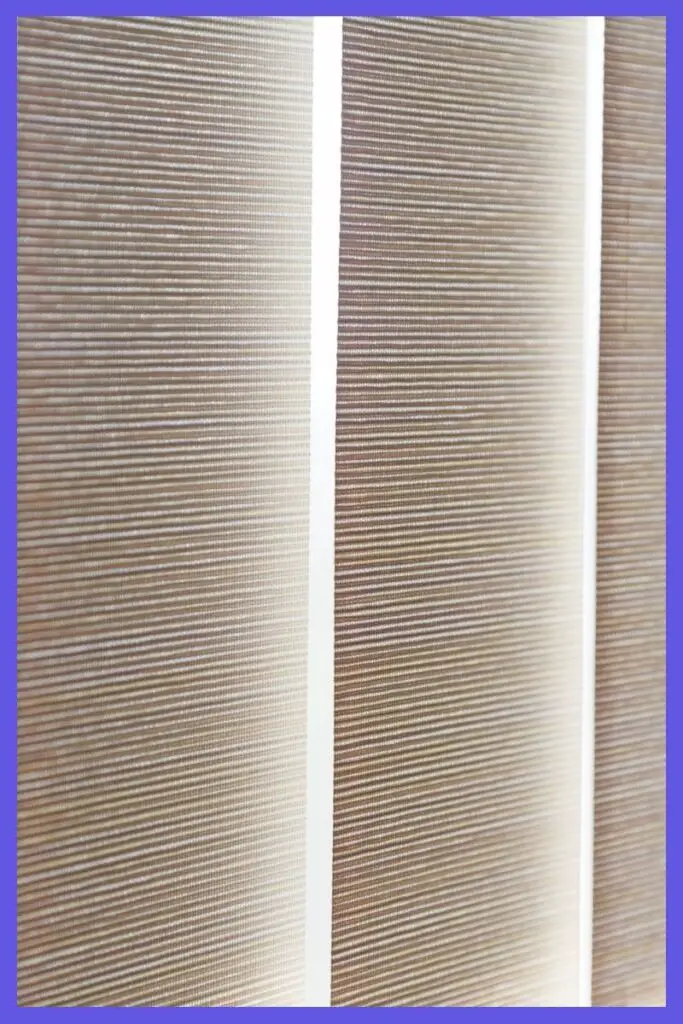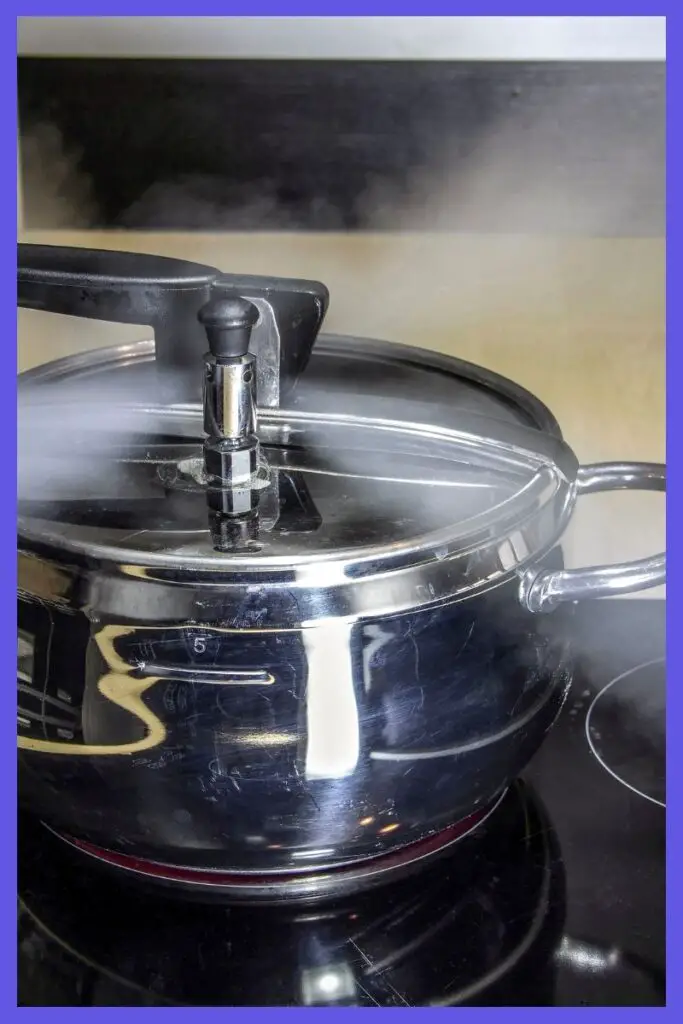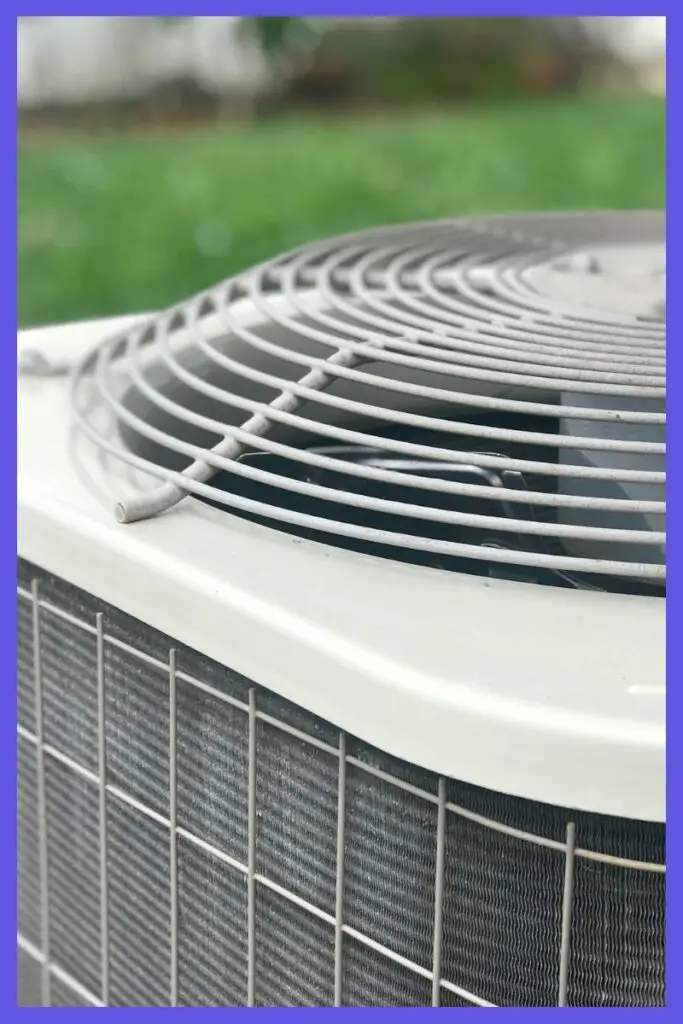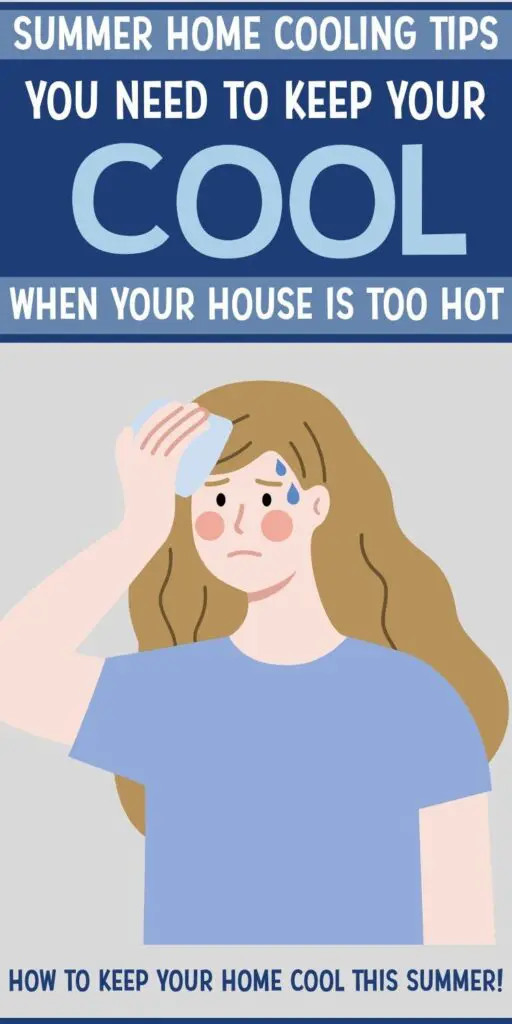Summer weather has finally arrived after a long, miserable winter. But you are sweating, frustrated, and you can’t sleep because your house is too hot in summer. So here you are, looking for some easy summer home cooling tips before you melt.
We live in an old house that is surrounded by farmland. It has large windows that let in a lot of sunshine, and a lot of heat! The land was cleared long ago, so there are no trees left to provide shade. We also have no central AC, so we’ve had to be creative in finding ways to keep cool.

This article outlines some causes of a hot house and provides some summer home cooling tips we’ve used to help keep our house cool and comfortable. Hopefully, by implementing some (or all) of them, you can get some sleep too – even in the heat of summer.
As an Amazon Associate I earn from qualifying purchases. This means if you click on a link and buy something I’ve recommended, I get a small commission at no additional cost to you. You can see my full Disclosure Policy here.
Related Post: Black glass stove top scratch repair – 6 easy ideas
Causes of a Hot House
Large windows or glass doors
Although large windows and glass doors open up your living space and allow radiant sunlight to flow in, they can be a source of heat buildup in the house. In winter, sunshine streams through glass and warms up your cold rooms. But in the summer, large surface areas of glass directly exposed to the sun’s rays heat the interior of the house directly, and also indirectly by heating the walls and other exposed surfaces of the house. Minimizing solar gain can help keep your home cooler.
Related post: Chill Out for Less: Cheap Ways to Block Heat from Windows
Inadequate ventilation
Ventilation is the exchange of indoor and outdoor air in your home. Without proper ventilation, an otherwise insulated and airtight house can hold moisture, causing high humidity levels that can raise indoor temperatures. Most modern homes are designed to be as air-tight as possible, which minimizes uncontrolled air movement in and out of the space. Moving air can remove heat from your home and help create a wind chill effect that cools your body.
Drafts or Air Leakage
The opposite of inadequate insulation, gaps and cracks in your home can leak warm air into your home and increase heat and humidity levels. Finding and blocking these leaks can help reduce the amount of warm air leaking into the house and keep the cool air in.
Related Post: Do you have a cold, drafty house? Easy fixes to draft-proof your home
Insufficient Cooling System
If your house has AC and you still think your house is too hot, you may have the wrong size AC for your space. An AC unit that is too small will have trouble cooling the entire space efficiently. An oversized air conditioner will cool all the air before it removes the humidity properly and that moisture will make you feel hotter.
Daily Activities
Using appliances like your oven can make the house feel hotter. Cooking, laundry, and showering can contribute to humidity levels. Minimizing use of appliances that create heat and reducing humidity in the home can cool it down.
Poor attic insulation
The most common cause of heat trapped in the house is poor insulation, especially in older homes. The sun’s radiant energy quickly heats the roof and much of this heat is transmitted through the roofing materials to the attic side of the roof. That hot air in the attic can radiate down into rooms below it if there is not enough insulation, or if the attic is not properly air sealed.
Poor wall insulation
South and west facing walls have high exposure to direct sun. If they are uninsulated or poorly insulated, the heat from the sun can radiate through the walls and heat up your home.
High thermal mass materials
High thermal mass materials like concrete, bricks, stone and tiles absorb and store heat and can take longer to cool to a lower temperature. It takes longer for these materials to release the heat stored in them and can be a reason your house is so hot. However, if they aren’t exposed to direct sunlight, they will stay cool and help keep the temperature more bearable. The most common use of high thermal mass materials in homes is flooring, walls and countertops.
Summer Home Cooling Tips
One of the most effective summer home cooling tips is to minimize the amount of sunlight that enters your house by installing shades, blinds, or curtains on your windows. You can also add reflective films or coatings to your windows to reflect sunlight away from your home.
Here are some tips on how to make your home cool in the summer.

Stay in the shade
Shade doesn’t actually lower the temperature because the air feels much warmer than it actually is when you are directly in radiant sunlight. Shade blocks the sun’s rays and makes the air feel cooler. If a house is exposed to direct sunlight for extended periods, it will heat up quickly and become difficult to cool down, especially if high thermal mass materials are used. Here’s some ways you can create more shade in and around your home:
Blinds Or Curtains
Install thermal blinds or curtains on your south and west facing windows and glass doors. Keep them closed during the day to block out sunlight and heat. Open them at night to promote ventilation.
Heat Reflective Film or Coating
Heat reflective window film is designed to reflect heat back outside and reduce the amount of heat transmitted through window glass. Most are easy to apply and stick to the window with static cling. The thin vinyl material works like mini suction cups when pressed onto a smooth, clean, and non porous surface.
Shade Sails
Shade sails block up to 70 percent of UV light and are a budget friendly, easy to install option for people who don’t want a more permanent shade structure outside their window.
Window Shutters
Window shutters that fit snugly against the window are an effective light barrier and still allow for some ventilation. Lighter color shutters better reflect light and radiant heat, making them an excellent choice for blocking heat and keeping your house cool.
Awnings
A strategically installed window awning may be a more permanent investment, but will help keep your home cool. In the winter, you can close your retractable awning to let the sun in and benefit from the extra warmth and light the sun provides.
Plant Trees or Bushes
Plant trees or bushes strategically around your windows to block out the sun’s rays. They block radiation through windows and cool the surrounding air and reduce your home’s temperature.
RELATED POST: How to blackout windows without breaking the bank

Ventilate
Proper ventilation can help circulate cool air throughout your house and remove hot air. This can be achieved by strategically opening windows and doors, or using fans and air conditioning units.
Ceiling Fans
Hot air generally rises, while cool air settles in the lower part of a room. A ceiling fan can help to pull cold air higher up, so it circulates around your face instead of your feet. We have ceiling fans going 24/7 to help circulate air and create a cool breeze.
Portable House Fans
Fans help moisture evaporate from skin. Evaporation transfers heat from your body to the ambient air, making you feel much cooler and reducing the need for air conditioning in some cases. Place portable house fans strategically to move cool air around your home.
Open windows at night
Open windows at night when the outside temperature is cooler to let cool air in and hot air out. This can be really effective when there is a breeze coming in through one side of the house and out the other.
Create airflow
We create airflow in our home by opening windows and/or doors, and using fans to create a wind tunnel. Place one fan facing in by the window where cool air is coming in, and one at an opposite window positioned to blow warm air out to create a “wind tunnel” effect to pull air through the house. This strategy can be especially effective at night when it is cooler.

Remove Humidity
Run a Dehumidifier
A good way to remove humidity from your home is with a dehumidifier. A dehumidifier works by using a fan to draw warm air currents into its coils. The warm air contracts as it’s fed through the refrigerated coils of the machine, and the condensation is contained in a bucket inside the dehumidifier that is periodically emptied. This is a good choice if you don’t have central AC and a portable AC unit isn’t an option for the room.
Absorb the Moisture
Place containers of DampRid in problem areas of your home to see a quick reduction in humidity levels.
Exhaust Fans
Run exhaust fans in the bathroom when bathing or showering and in the kitchen when boiling liquids to keep the humidity level down. If they are not working, it’s time to replace them.
Vent Dryers
A dryer by its very nature generates hot moist air when operating. A dryer that is not venting moist air to the outdoors can cause heat and humidity to build within the laundry room. It’s easy to install a dryer vent to force that heat and humidity out of the house.
Install a Window AC Unit
This may sound like a no-brainer, but the fastest way to cool a room without central AC is with a window air conditioner, especially in your bedroom so you can get some sleep. If your window is not suitable for a window unit, try a portable air conditioner that just needs a small space to be vented outside.
Related post: 10 Kitchen appliances that make life easier

Block Drafts and Air Leaks
Seal Doors and Windows
One of the main causes of air leaks in your home is doors and windows. There are many easy ways of sealing leaky doors and windows, including tightening hinges on doors, replacing weather stripping, installing a door sweep or draft stopper, and sealing windows with caulking.
Floors and Baseboards
Gaps in floorboards can allow hot air to leak up and into the room. Another source of air leaks at floor level is gaps between the floorboards and the walls which allow hot air in through the baseboards.
Other Gaps and Cracks that Leak Air
Electrical outlets, light switches and fixtures are some of the common places where air seeps into a room. Hidden cracks or holes around any built-in features of your home also allow hot air to sneak in.
Check out these easy fixes to draft-proof your home to find and seal air leaks in your home.

Have your Cooling System Serviced
If your air conditioning system isn’t keeping house cool in extreme heat and you’re feeling hot, it’s a good idea to have it checked out by a professional HVAC technician. Some potential problems making your house too hot when you have AC could be:
- The unit is too small for the space
- Filter is dirty and needs to be replaced
- The unit is low on refrigerant
- The motor is worn
- The evaporator coil is dirty
- Air leaks in ductwork
- Debris is clogging outside unit
Update the insulation in your home
If none of the above tips help to make your home cooler, you may want to take a look at the insulation in both your attic and walls.
Evaluate your current insulation
Check your attic and wall insulation to determine if it needs to be updated or replaced. You can hire a professional to do this or inspect it yourself if you are comfortable with it.
Choose the right type of insulation
Once you have evaluated your insulation, you need to choose the right type of insulation that will keep your house cool. The most common types of insulation are fiberglass, cellulose, and spray foam.
Replace insulation in the attic
The attic is a prime spot for insulation as it can trap heat and let it radiate into your home. Insulation can be installed in the attic by laying rolls of fiberglass batts or blown-in cellulose insulation.
Install insulation in the walls
Installing insulation in the walls can be more challenging than in the attic, as it requires removing sections of drywall or siding. You can hire a professional to install blown-in cellulose insulation or foam insulation.
Overall, updating both attic and wall insulation can help keep your house cool, reduce energy costs, and make your home more comfortable.

10 Additional Summer Home Cooling Tips
Here are 10 more summer cooling ideas that can help when your house is too hot:
Stay Hydrated
The human body contains a high proportion of water, so when the temperature rises and the body tries to cool itself by sweating, dehydration can occur, particularly in children. Drink plenty of water and other fluids to stay hydrated in the heat.
Eat Light, Refreshing Foods
Fresh, raw fruits and vegetables naturally contain more water. Eat light, refreshing foods like cucumber, celery, lettuce in salads and fruits like berries and melon to stay cool and hydrated.
Get Wet
When water on your skin evaporates, heat is absorbed from your skin into the water droplets, providing a cooling effect.Take cool showers or baths, or even just wet yourself with a cloth, to lower your skin temperature and stay refreshed. Get an extra cooling boost by sitting in front of a fan.
Wear Loose, Light-Colored Clothing
Some colors absorb and trap the sunlight more than others. Light-colored clothing easily reflects the sunlight, while dark clothes can absorb the sun’s rays.Wear loose-fitting clothing made of light-colored fabrics that are breathable and allow air to circulate.
Use Cool Sheets And Bedding
Cotton absorbs the sweat from our body and exposes it to the air for evaporation. This evaporation cools our body. Use cool cotton or linen sheets and lightweight bedding to stay comfortable at night.
Use Cooling Products
Use cooling products like gel cool packs, cooling towels, neck wraps or fans that spray mist to stay cool.
Cook Outside
Cooking generates heat inside your home. Cook outside on a grill or eat cold meals to avoid heating up your home with the oven or stove.
Create A Cool Outdoor Space
If you have the space, setting up a cool outdoor space like a shaded porch or covered patio will help keep you cool in hot weather.
Use Evaporative Cooling Techniques
If you are in a dry climate, passive cooling techniques like evaporative cooling can help keep you cool. Wet towels or blankets and hang them in front of an open window to cool incoming air. Or make your own swamp cooler to lower the temperature in the room.
Use Energy Efficient Light Bulbs
Lights and light fixtures are basically electric space heaters that have a useful byproduct: visible light. Fluorescent light bulbs use less energy than an incandescent bulb and are ideal for offices, kitchens, hallways and other areas that need a large area of light. Fluorescent bulbs also produce about 75% less heat than incandescent bulbs, so they keep rooms cool with less energy. You will also save money on your home energy bills.
Keeping your windows shaded, increasing ventilation, controlling humidity and preventing air leaks are the key to keeping your house cool in the summer heat. These easy summer home cooling tips can help you finally get a good night’s sleep and stop worrying about why your house is too hot in summer.

